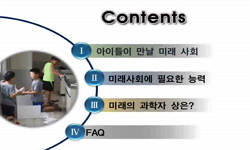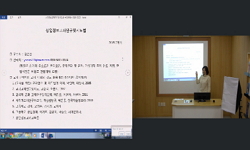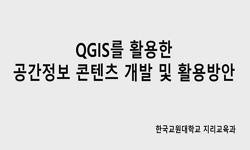The purpose of this study was to examine the awareness of students with low vision about instruction of a map and problems with that instruction in a bid to suggest some of the right directions for map instruction geared toward students with low visio...
http://chineseinput.net/에서 pinyin(병음)방식으로 중국어를 변환할 수 있습니다.
변환된 중국어를 복사하여 사용하시면 됩니다.
- 中文 을 입력하시려면 zhongwen을 입력하시고 space를누르시면됩니다.
- 北京 을 입력하시려면 beijing을 입력하시고 space를 누르시면 됩니다.

저시력 학생의 ‘지도 이해’ 수업에 대한 질적 사례연구 = A Qualitative Case Study of Students with Low Vision in Class ′the Understanding of a Map′
한글로보기https://www.riss.kr/link?id=A104633401
- 저자
- 발행기관
- 학술지명
- 권호사항
-
발행연도
2010
-
작성언어
Korean
- 주제어
-
등재정보
KCI등재
-
자료형태
학술저널
-
수록면
71-92(22쪽)
-
KCI 피인용횟수
2
- 제공처
-
0
상세조회 -
0
다운로드
부가정보
다국어 초록 (Multilingual Abstract)
The purpose of this study was to examine the awareness of students with low vision about instruction of a map and problems with that instruction in a bid to suggest some of the right directions for map instruction geared toward students with low vision. The subjects in this study were four students with low vision at the special school for visual impairment students in Chungju. After they took special lessons in understanding of a map, an in-depth interview was held. The findings of the study on the perception of the students about instruction of map were as follows:First, as for awareness of signs, they generally had a good understanding of signs that were similar to the real images of things such as schools or churches or that they already have learned from their experiences. But they found it quite difficult to make out signs that showed some particular characteristics of things like the signs of railroads, and they also had difficulties in understanding signs that represented things of which they didn't know the exact meaning or characteristics like patches or rice fields. Second, concerning perception of directions, they considered it hard to form an overall space conception due to their low vision, and they perceive that the directions of real life are an entirely separate entity from those of map. Third, regarding awareness of scale, they got to make out the concept of scale that a real size was reduced on a map when they learned about that by walking on the school ground, but they felt that scale was difficult to learn probably because it needed calculation. Besides, they complained that the mark of scale on a map was too small to discriminate due to their low vision. Fourth, perception of a contour, they were able to make out the concept of a contour when they learned about that by cutting onions and potatoes, but the interval of contours on a topographical map was too small, and it was impossible to discriminate the contours without using an aid. Moreover, they couldn't often discriminate even colored contours, since they faced difficulties in discriminating colors because of low vision.
The findings of the study about map reading and inquiring into surroundings by using a map were as follows:A lot of information that were included on a map in relation to map reading just looked complicated for the students with low vision, and they didn't make the most of the information as what's necessary to read the map. They only made use of selective information what they easily understood like signs or relied on the name of a place written on the map. In relation to searching surroundings by utilizing a map, they chose a place that they had already visited, which made it possible for them to search the place by using a map with little troubles, but they preferred to rely on their own prior experiences instead of utilizing the topographical map, or preferred to ask around people based on their experiences of walking training which was provided as part of remedial education. Basically, they should be able to find out their location by reading a map to arrive at a final destination, but the students with low vision couldn't see the outline of things and eventually had difficulties in utilizing a topographical map.
Finally, the findings of the study on the utilization of a map through information media were as follows:They didn't feel rejective toward computer, probably because digital equipment was easily accessible, but they complained that it was not easy for them to retrieve online maps provided by portal sites because of the complexity of the maps. For students with normal vision, it was so easy to input keywords and click a place of departure and destination with a mouse, but they took a lot of time to do that. In regard to the use of a car navigation system, a portable GPS-based equipment, the students had interest in that when they used the navigation in a car, since a digital map was intriguing. But they intended to t...
국문 초록 (Abstract)
본 연구는 저시력 학생들에게 지도 수업이 어떻게 인식되고 있는지를 알아보고, 실제 수업에서 나타난 다양하고 사실적인 문제점을 파악하면서 저시력 학생들을 위한 더욱 효과적이고 합리...
본 연구는 저시력 학생들에게 지도 수업이 어떻게 인식되고 있는지를 알아보고, 실제 수업에서 나타난 다양하고 사실적인 문제점을 파악하면서 저시력 학생들을 위한 더욱 효과적이고 합리적인 지리수업 방향을 제시하는데 연구의 목적을 두고 수행되었다. 이를 위해 충청북도에 소재한 시각장애학교에 재학 중인 저시력 학생 4명을 대상으로 ‘지도 이해’라는 특별수업을 실시하였고, 그 학생들을 대상으로 심층면담을 실시하였다. 본 연구의 결과를 통하여 얻은 결론은 다음과 같다. 저시력 학생들은 시력과 시기능에 있어 다양한 개인차를 보이고 있어 시각 의존도가 높은 지도 이해에 어려움을 보인다. 또한 지도에 표시된 다양한 기호, 방위, 축척, 등고선 등은 지도의 제시 목적과 성격에 맞추어 그 내용을 간략화 하거나 대비의 강조 및 부분 확대 등을 통해 저시력 학생들에게 제공되어야 하고, 보행 훈련과 사회과 지도 이해 수업을 교과 통합적으로 운영할 필요성이 있으며, 각종 정보 매체 활용을 통해 지도의 시각적 정보 제공뿐만이 아니라 청각과 촉각을 병용한 기기들이 개발되어야 할 것으로 보여진다.
참고문헌 (Reference)
1 교육과학기술부, "특수학교 교육과정 해설" 교육과학기술부 2009
2 교육인적자원부, "특수학교 교육과정" 교육인적자원부 2008
3 조인수, "특수교육 교사를 위한 수업개선 방법과 실제" 대구대학교출판부 2004
4 권동희, "지형 도 읽기" 한울아카데미 2007
5 류재명, "지리-수업활동 조직화에 관한 연구" 서울대학교대학원 1992
6 이희연, "지도학-주제도 제작의 원리와 기법" 법문사 2007
7 한균형, "지도학 원론" 민음사 2000
8 이승옥, "지도를 활용한 지역학습의 설계 및 적용방안: 중학교 「사회 1」〈지역과 사회 탐구〉단원을 중심으로" 제주대학교 교육대학원 2004
9 이해균, "저시력 교육" 대구대학교출판부 2006
10 임안수, "신보행학 개론" 한국맹인복지연합회 1999
1 교육과학기술부, "특수학교 교육과정 해설" 교육과학기술부 2009
2 교육인적자원부, "특수학교 교육과정" 교육인적자원부 2008
3 조인수, "특수교육 교사를 위한 수업개선 방법과 실제" 대구대학교출판부 2004
4 권동희, "지형 도 읽기" 한울아카데미 2007
5 류재명, "지리-수업활동 조직화에 관한 연구" 서울대학교대학원 1992
6 이희연, "지도학-주제도 제작의 원리와 기법" 법문사 2007
7 한균형, "지도학 원론" 민음사 2000
8 이승옥, "지도를 활용한 지역학습의 설계 및 적용방안: 중학교 「사회 1」〈지역과 사회 탐구〉단원을 중심으로" 제주대학교 교육대학원 2004
9 이해균, "저시력 교육" 대구대학교출판부 2006
10 임안수, "신보행학 개론" 한국맹인복지연합회 1999
11 김종무, "시각장애학생의 교과지도를 위한 정 보매체 활용" 국립특수교육원 2000
12 김홍선, "시각장애학교 교사와 학생의 지리교과에 대한 인식 분석" 대구대학교 특수교육대학원 2002
13 박순희, "시각장애아동의 이해와 교육" 학지사 2005
14 김정현, "시각장애 학생의 웹 접근성에 관한 연구" 대구대학교 대학원 2002
15 김연옥, "사회과 지리교육연구" 교육과학사 1999
16 노웅희, "교실 밖 지리여행" 사계절 출판사 1994
17 Lowenfeid, B., "Psychological foundation of special method in teaching blind children" University Press 1950
동일학술지(권/호) 다른 논문
-
병원학교 입급 학생의 교육목적과 교육방법에 대한 병원학교 교사의 인식 특성
- 한국시각장애교육&재활학회
- 김영한
- 2010
- KCI등재
-
- 한국시각장애교육&재활학회
- 이상호
- 2010
- KCI등재
-
학교 급별 장애학생 부모의 통합교육 서비스 만족도 비교
- 한국시각장애교육&재활학회
- 박미화
- 2010
- KCI등재
-
시각장애인 독서활동지원기관 사서의 조직몰입 영향요인에 관한 연구 - 직무수행능력, 역할모호성, 직무만족과의 관계 검증 -
- 한국시각장애교육&재활학회
- 최지선
- 2010
- KCI등재
분석정보
인용정보 인용지수 설명보기
학술지 이력
| 연월일 | 이력구분 | 이력상세 | 등재구분 |
|---|---|---|---|
| 2023 | 평가예정 | 재인증평가 신청대상 (재인증) | |
| 2020-01-01 | 평가 | 등재학술지 선정 (재인증) |  |
| 2019-04-24 | 학회명변경 | 영문명 : Korean Association For Education & Rehabilitation Of Visually Impaired -> Korea Association for Education & Rehabilitation of the Visually Impaired |  |
| 2019-01-01 | 평가 | 등재후보학술지 유지 (계속평가) |  |
| 2018-01-01 | 평가 | 등재후보학술지 유지 (계속평가) |  |
| 2017-12-01 | 평가 | 등재후보로 하락 (계속평가) |  |
| 2013-01-01 | 평가 | 등재 1차 FAIL (등재유지) |  |
| 2010-01-01 | 평가 | 등재학술지 선정 (등재후보2차) |  |
| 2009-01-01 | 평가 | 등재후보 1차 PASS (등재후보1차) |  |
| 2008-01-01 | 평가 | 등재후보 1차 FAIL (등재후보2차) |  |
| 2007-01-01 | 평가 | 등재후보 1차 PASS (등재후보1차) |  |
| 2005-05-11 | 학회명변경 | 한글명 : 한국시각장애연구회 -> 한국시각장애교육•재활학회 |  |
| 2005-01-01 | 평가 | 등재후보학술지 선정 (신규평가) |  |
학술지 인용정보
| 기준연도 | WOS-KCI 통합IF(2년) | KCIF(2년) | KCIF(3년) |
|---|---|---|---|
| 2016 | 0.48 | 0.48 | 0.53 |
| KCIF(4년) | KCIF(5년) | 중심성지수(3년) | 즉시성지수 |
| 0.6 | 0.6 | 0.648 | 0.04 |




 KCI
KCI 스콜라
스콜라






